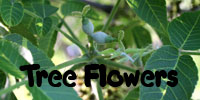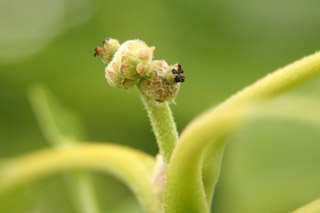


|
Tree Flowers (and fruits)
Bur-oak (Quercus macrocarpa)
Q. Hey, what's the coldest tree? A. Bur-oak (brrr-oak?).
Q. What was J.S. Bach's favorite tree? A. Bur-oak (baroque?).
O.K. Enough with the jokes already. Bur-oak is a beloved and
magnificent tree, well known for being the only tree that grows in
prairies. Grasslands with scattered trees are called "savannas." There
is a magnificent savanna in Crawford County, the Daughmer Bur-oak
Savannah where this species reigns supreme.
Daughmer Bur-oak Savannah, Crawford County, OH.
Other species of trees, even native ones
such as ashes and maples, are considered weeds in prairies. If
ever a windstorm were to sweep through Daughmer Savanah and damage
trees, the instructions to tree surgeons dispatched to remedy the
damage would be very clear: "If it ain't bur-oak, don't fix it!."
Bur-oak trees are being preserved at the Ted Myers Savannah, and have
been planted at the Larry R. Yoder Prairie, both located at
OSU's Marion campus.
Bur-oak at the OSU's Marion Campus
A common pattern for some wind-pollinated species such as oaks, hickories
and walnuts, is for the pollen-producing male flowers to be
individually tiny, but presented abundantly in elongate drooping
finger-like catkin. Nearly on the same tree there are female
flowers which are slightly larger, and much fewer in number. These
eventually mature into the familiar nut or nut-like fruit.
During the spring and summer of 2007 I followed the progress of flowering on a bur-oak tree. This species is monoecious,
i.e., the individual flowers are either male or female, but both types
are borne on the same tree. Being wind-pollinated, the flowers are not
showy.
Flowering branch of bur-oak, May 10, 2007, Marion, OH.
Seen
closer, the female flowers display
pollen-receptive stigmas that seems to have a remarkably small
surface area in comparsion with many other wind-pollinated trees.
(Contrast this with the fairly elaborate "rabbit
ears" of walnut.)

Black walnut pistillate flowers, May 10, 2007, Marion, OH.
By the following week the staminate catkins withered and soon after they fell from the tree.
 Spent staminate catkins of bur-oak, May 18, 2007, Marion, OH.
Spent staminate catkins of bur-oak, May 18, 2007, Marion, OH.
Over the next month, the baby acorns slowely got bigger.
 
Bur-oak very young fruits in mid-spring,
2007 (left: May 18, and right: May 25). By this time the spent
staminate catkins have
fallen to the ground.
 
Bur-oak young fruits in late spring and early summer, 2007 (left: May 30, and right: July 7).
By late summer the acrons are almost
ripe, ready to be snatched by a squirrel or fall to the ground.

Bur-oak acorn, September 5, 2007, Marion, OH.
Oaks (genus Quercus) are neatly
divisible into two sub-genera: (1) the white oak group, and (2) the red
oak group. White oaks, including bur-oak, mature their acorns in one
year, while red oaks take two years to develop. Acorns are nuts, and,
although bitter owing to the presence of tannic acid, are edible (some
moreso than others). The tannic acid can be leached out by boiling
and changing the water frequently.

Bur-oak tree, September 16, 2007, Marion, OH.
HOME TREE FLOWERS MENU
|







